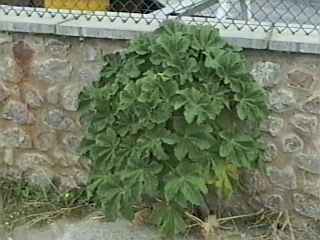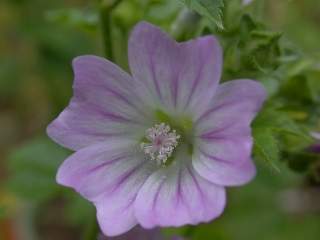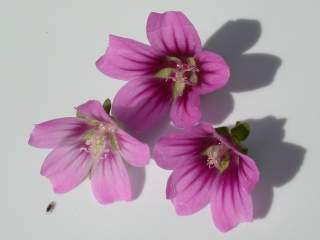


back to Contents and Overview
Lavatera arborea L. (Malva arborea (L.) Webb & Berthel.)
Lavatera cretica L. (Malva pseudolavatera Webb & Berth.)
Lavatera mauritanica Durieu (Malva durieui Spach)
Lavatera microphylla E.G. Baker (Malva microphylla (E.G. Baker) Molero & J.M. Monts.)
Lavatera vidali Pau (Malva vidali (Pau) Molero & J. M. Monts.)
 |
 |
 |
| arborea | cretica | mauritanica |
Introduction
The Tree Mallows are a group of 5 species with a Mediterranean-Atlantic distribution. They appear not to be a natural grouping, forming a clade with the Pacific Lavateras (Californian Lavateras and Australian Hollyhock), Malva sylvestris, and the weedy mallows of cool temperate climates. The first 2 were transferred to Malva in 1998 by M.F. Ray, on the basis of flower and fruit axis characteristics, and DNA sequences, as Malva dendromorpha M.F. Ray and Malva linnaei M.F. Ray [1]. In the absence of DNA evidence he refrained from transferring Lavatera mauritanica. Subsequent DNA sequence data from Escobar et al [2] confirms its position in Malva, where the correct name is Malva durieui Spach.) Lavatera microphylla and Lavatera vidali are obscure Moroccan species which are grouped with the tree mallows, and transferred to Malva, by Molero and Montserrat [3]. The correct names for the first two species are Malva arborea [4] and Malva pseudolavatera Webb & Berth. [3, 5].
I continue to present these species under Lavatera as it is under this name that they are still generally known, especially in the horticultural literature. For a description under Malva see here.
Lavatera arborea is the Tree Mallow, and Lavatera cretica the Smaller Tree Mallow. These names are misleading; Lavatera arborea is a biennial, occasionally perennial, sub-shrub with erect stems to 3m height, woody below, and Lavatera cretica an annual or biennial herb growing to 1 or exceptionally 1½m.. Lavatera cretica is also known as the Cornish Mallow. Lavatera mauritanica is an erect annual.
Lavatera arborea is of horticultural merit, and is occasionally found in gardens, especially as cultivar 'Variegata'. Lavatera cretica and Lavatera mauritanica are also grown, but in my experience the flowers are neither sufficiently showy nor abundant for them to warrant a place in a garden. This may be different in hotter climates; I have observed a reluctance for the flowers to open on overcast days.
 Lavatera arborea L.
Lavatera arborea L.
![]() Tree Mallow, Velvet Tree Mallow
Tree Mallow, Velvet Tree Mallow Lavatera Arborescente, Lavatère, Mauve de Jardin, Mauve royale
![]() Grande Mauve
Grande Mauve![]() Mauve, eune mauve
Mauve, eune mauve Malva arbórea, malva arborescente, malva gigante
malva, Malva d'arbre, Malva fogassa, malva gran, malva reial, malvera, mauvera, vauma, vaumera
![]() malvaísco
malvaísco Malva arborea, Malva reale, Malvone, Malvone maggiore
![]() Marvòni, narbóina
Marvòni, narbóina Baumförmige Strauchpappel, Baummalve, Strauchmalve
![]() Mak kiesieblaar
Mak kiesieblaar Jättemalva
Træagtig Poppelrose
puis-rõngaslill
![]() Slézovec, slézovec stromový
Slézovec, slézovec stromový Drevesasti grmièasti oslez
drvolika stola
krūminė dedešva
![]() Hocyswydden
Hocyswydden Hocas ard
Δενδρομολόχα
![]() lavatero roka, malvo roka
lavatero roka, malvo roka Hobbejza tas-sigra
Detailed description with photo-illustrations.
Distribution:
Lavatera arborea is found on the coasts of the Mediterranean and Western Europe, and in North Africa. In Britain it is found principally on the south and west coasts (as far north as Ayr) and on the south coast of Ireland, but also occurs on the east coast, e.g. East Lothian. It is naturalised in many locations, including coastal California, Victoria and Swanland in Australia, and the Canary Islands.
Description:
The non-woody parts of Lavatera arborea are downy to hairy (with star-shaped hairs). The velvety leaves are 5-7 lobed. The flowers are 3-5cm across, and are lilac or purplish-pink in colour with purple veins, and darker bases. They are borne in terminal racemes. The epicalyx is a 3-lobed cup of broadly oval segments wider than the calyx, especially in fruit. The nutlets are wrinkled.
Cultivars:
Lavatera arborea 'Variegata' is a variegated cultivar. It is sparsely variegated, or unvariegated, in its 1st season, followed in subsequent seasons by leaves and epicalyxes heavily marbled with white.
Detailed description with photo-illustrations.
Other recorded cultivars are 'Alborosea', 'Isle de Hyères' and 'Molly Miller'.
Lavatera arborea 'Rosea' is an incorrect name for Lavatera ×clementii 'Rosea'
Photographs
photographs in the Lavatera Gallery
(herbarium) photograph at Universtiate de les Illes Balears
10 detail photographs at BioImages: The Virtual Field-Guide (UK)
photograph at Isola Tremiti
3 photographs at Department of Botany, U of Catania
Cultivation:
Lavatera arborea prefers a light well drained moderately fertile soil in full sun, but will succeed in any ordinary garden soil in sun or partial shade. Too fertile soil, or overuse of fertiliser, will encourage vegetative growth at the expense of flowering. Though not strictly a biennial, it is commonly monocarpic, and is best treated as a biennial
It is hardy to zone 8, and must be treated as an annual or a half-hardy biennial in the remainder of North America.
Lavatera arborea should not be pruned in its 1st season.
Propagation:
Grown from seed, sown in situ in late summer. Generally produces good seed, and will self seed. (In some parts of the world it is a potential weed.)
 Lavatera cretica L.
Lavatera cretica L.
![]() Cretan Hollyhock
Cretan Hollyhock![]() Cornish Mallow, Smaller Tree Mallow
Cornish Mallow, Smaller Tree Mallow![]() Cretan Mallow
Cretan Mallow![]() Cretan Mallow
Cretan Mallow lavatére de Crête, Malvones, mauve de Crête
Malva(loca), malvones
malva, malva crètica
![]() malva-bastarda
malva-bastarda malva di creta, malvone di Creta
![]() marva
marva Kretische Strauchpappel
falsk rödmalva, narrmalva
Rikkamalvikki
![]() slézovec krétský
slézovec krétský ![]() Morhocysen Fychan
Morhocysen Fychan![]() lavatero rozkolora, malvo rozkolora
lavatero rozkolora, malvo rozkolora
Detailed description with photo-illustrations.
Lavatera cretica is an erect hairy annual or biennial found in the Near East and Mediterranean region, including North Africa and the Canary Islands, and in Western Europe north to Brittany and Cornwall, growing to 2-4 feet in height. It is also found (naturalised?) in Madeira and the Azores, and is naturalised in a number of other regions. It bears small lilac flowers, in clusters in the leaf axils, in early summer.
Photographs
photographs in the Lavatera Gallery.
photograph at Department of Botany, U of Catania
photograph at Belles Fleurs de France
 Lavatera mauritanica Durieu
Lavatera mauritanica Durieu
Lavatera mauritanica ssp davaei (Coutinho) Coutinho
Malva mauritánica
Detailed description with photo-illustrations.
Lavatera mauritanica is an erect hairy annual (with stellate hairs) from south and central Portugal and eastern Spain (ssp. davaei) and north west Africa (ssp. mauritanica) growing to 2-4 feet in height. It bears small rose-pink flowers, with darker eyes, in pairs in the leaf axils, in early summer.
Photographs
photographs in the Lavatera Gallery.
Lavatera microphylla E.G. Baker
Lavatera microphylla is a herbaceous plant, growing to 1 ft in height, with serrate, ovate, trilobate leaves, and slightly bilobate purple flowers. It is found in the region of the Sherat River, in the vicinity of Rabat in Morrocco.
Synonyms of Malva microphylla include Althaea microphylla Kuntze and Lavatera microphylla Baker f..
Lavatera vidali is known from a single collection from Morocco. It is distinguished from Lavatera cretica in being consistently annual, and in having long petioles (leaf stalks) [3].
Lavatera vidali Pau is a synonym of Malva vidali.
References
back to Contents and Overview
© 1999, 2000, 2001, 2002, 2003, 2008 Stewart Robert Hinsley